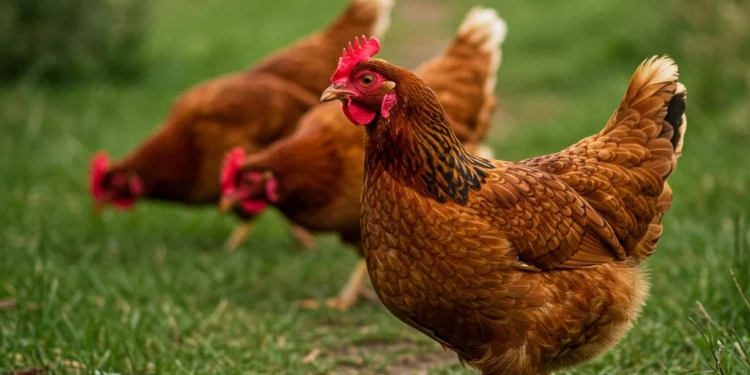Fly season can be a difficult time for chicken keepers who are beginners in the field. These birds come with their own wonders and surprises for new poultry owners. The most surprising is the fact that these birds show a natural urge for short bursts of flight.
While these bursts rarely resemble the long-distance movement of wild birds, they can still create challenges within your yard or chicken coop. In fact, a question that many owners ask is: Can chickens fly in ways that risk escape? Well, the answer is ‘yes’ and thus new keepers need strategies that can help them manage their flock’s flying instincts with ease. Let’s explore these useful tips in detail.
Why Birds Seek Flight
Chickens lift themselves with short flaps when startled, excited, or when they try to reach a perch. This instinct reflects their heritage, even though the present domesticated breeds are heavier than their wild ancestors. Most backyard chickens manage only brief, low flights, yet it remains enough for them to scale a fence or leave the intended enclosure.
New keepers soon realize that flight is more about instinct and exploration than long-distance travel. By seeing it in this way, newcomers avoid frustrating battles with their flock and develop patience for better solutions. These short flights are their way to escape perceived threats or simply satisfy curiosity. Understanding this behavior helps in making practical decisions about containment and care.
Set Up A Secure Enclosure
The enclosure is the most important factor in guiding poultry behavior. A fence that is too low invites birds to leap over, while narrow spaces without enrichment encourage restlessness. Every coop and run should include both height and suitable features, such as roosting bars and shaded areas. These elements direct the birds’ energy into safe habits within the enclosure.
A tall perimeter fence, paired with a covered run if possible, keeps a flock safe from stray movements and from nearby predators that hide in wait. Well-planned enclosures lower the chance of escapes and make daily flock management simpler. Secure surroundings promote calmness among the birds and build their trust in the keeper’s care.
Create A Comfortable Environment
A flock that feels secure within its yard shows fewer attempts to escape. Simple adjustments make a difference: shaded corners help with summer heat, perches allow for natural instinct, and dust bath areas reduce stress. Ample space in the yard boosts contentment and lowers the desire to escape by flight or jump.
Variety in the enclosure keeps the flock active and reduces boredom, which is one of the common reasons they try to leave. Happier birds stay in place, while frustrated ones look for ways out. Comfortable living conditions encourage peaceful behavior and help reduce flight attempts caused by anxiety. When you keep birds occupied with natural activities, it contributes to a well-balanced flock environment.
Train Birds Through Habits
Chickens respond to routine and can learn to return quickly to their coop at dusk. When keepers guide the birds with feed rewards or treats, they establish regular patterns that build trust. Birds that associate the coop with safety and rest will not seek escape as frequently. Daily habits become second nature and form an invisible boundary that is just as important as the physical fence.
Small, consistent actions from the keeper create stronger discipline than forceful restraint. Routines such as feeding times and roosting calls build familiarity and comfort. This predictable environment reassures chickens and reduces their urges to explore beyond safe zones.
Cover The Run With Netting For Lighter Breeds
Lightweight chicken breeds have more agility and a stronger urge to fly. When you cover the coop’s run with sturdy netting blocks, any chance of escape through flight. It also keeps predators out of the enclosure from above. This simple addition safeguards smaller or more active birds while allowing freedom inside the run.
The netting should be durable and tightly secured to prevent sagging or gaps. Full coverage protects your flock from aerial threats and unwanted departure. Strong support posts and proper fasteners keep the netting firm and stable through all weather conditions.
Regularly Check Gates And Fences
Small gaps or broken sections in fencing lead to unintended escapes. Frequent inspections of gates, latch mechanisms, and fence lines prevent problems before they start. Maintenance ensures the integrity of the enclosure and reduces the need for drastic containment measures.
Keeping tight boundaries benefits both chickens and their keepers. Repairing even tiny holes helps avoid surprise escapes or predator entry. Regular upkeep protects your investment and keeps the flock safe and contained. Routine fence maintenance also prevents costly repairs and ensures long-term security for your birds.
With the right approach, the question ‘Can chickens fly’ becomes less of a concern and more of a reminder that human care helps guide their instincts wisely. Beginners need not worry if their flock shows short bursts of flight. This natural trait reflects instinct rather than full capacity for soaring. Secure the enclosure, trim when necessary, develop safe routines, and balance freedom with safety to help gain control over your flock.












